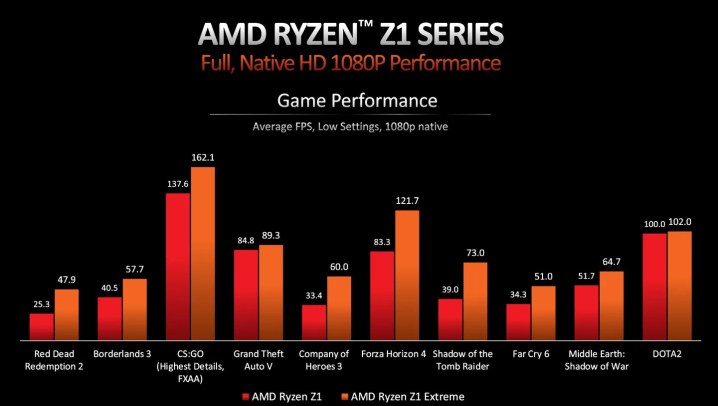
AMD’s Ryzen Z-series portable gaming processors have been some of the most exciting chips AMD’s released in recent years. They offer incredible CPU and GPU performance on a single die, with great efficiency, making it possible for higher performance portable gaming systems that can play at higher detail and frame rates. AMD’s second-generation Z2 portable processors debuted in 2025 and will form a core component in many portable gaming systems this year, like the Lenovo Legion Go S.
But often these portable systems offer last-generation Z chips designs, too, raising the question, which is better? Two chips that will go head to head early this year are the Z2 Go and Z1 Extreme, so let’s see how they stack up, to see which might be the better option.
Pricing and availability

Pricing for these individual processors is redundant, since you won’t be buying them by themselves, but pricing per device is going to vary dramatically by manufacturer. In the case of the Lenovo Legion Go, where both chips will be an option eventually, the Z1 Extreme version is available now, with an $800 price tag and Windows 11 installed.
In May, Lenovo will launch the Legion Go S with Steam OS as an alternative, with the option of the Z2 Go and more modest companion hardware — such as less memory and onboard storage. Prices there, will start at $500.
Specifications
| AMD Ryzen Z1 Extreme | AMD Ryzen Z2 Go | |
| Architecture | Zen 4 | Zen 3 |
| Cores/Threads | 8/16 | 4/8 |
| Boost clock | 5.1GHz | Up to 4.3GHz |
| GPU | 12 core RDNA 3 | 12 core RDNA2 |
| TDP | 9-30W | 15-30W |
On paper, the Z1 Extreme shows much more capable internals than the Z2 Go. Despite the latter being the newer processor in terms of release availability, the Z1 Extreme is built on a newer architecture, with a new graphics core design, more cores, and a higher clock speed. It’s the more expensive chip, in the more expensive version of the device, so we’d expect it to perform better.
How much better? That remains to be seen.
Performance

The specific performance of any hardware in any portable device is very dependent on the overall design. Available power and cooling play a huge role in how fast a processor can run at, and the operating system plays a big part too, so judging how these CPUs will square off without comparable testing using the same devices, is tricky.
However, it is possible to make some estimations by comparing how these chips perform in different devices. While we haven’t had a chance to do this testing ourselves, others have managed to run the Lenovo Legion Go S running the Z2 Go versus the Asus Rog Ally X, running the Z1 Extreme.
At a fixed 20W TDP, the chips performed comparably well in demanding games, managing over 40 FPS in Cyberpunk at 1080p low, with FSR enabled. However, when we consider all of the tests conducted in the above video, the Z1 Extreme delivers 10% higher frame rates across most games.
Although this does give a single-source win to the Z1 Extreme, it’s also a real success story for the Z2 Go. Despite using an older Zen 3 architecture, with fewer cores, and limited to a 4.3GHz boost clock, it’s able to leverage its high-core GPU to great effect — almost keeping up with the higher-power, more expensive alternative. It suggests that the Legion Go S with the Z2 Go chip could be a potent combination and has the potential to undercut the Steam Deck as the better budget handheld gaming solution in early 2025.
While the Z1 Extreme version is faster, it’s also more expensive, pushing it into competition with higher-end handheld gaming systems like the aforementioned Ally X, not to mention new competition coming this year.
Z1 Extreme is better, but is it worth it?
We’ll need to see head to head testing of the different versions of the Legion Go S — and any other handheld gaming systems with multiple chip options — to know for sure how these processors compare head to head. However, for now, it seems likely that the Z1 Extreme will be the fastest of the two CPUs, but just not by as much as we might have expected.
The margins for performance, pricing, and efficiency are extremely tight on portable gaming devices, so if the Z2 Go can offer near-enough performance to the Z1 Extreme at a much more affordable price, with comparable battery life, for many that will make it the no-brainer choice.
For now, though your options are limited. The Z1 Extreme version of the Legion Go S is ready to game on right now. The wait for something cheaper might be worth it for you, but if not, the Z1 Extreme is already the more capable option; albeit at a higher price tag.





